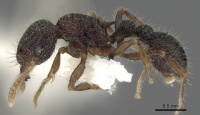Tetramorium rugigaster
| Tetramorium rugigaster | |
|---|---|

| |
| Scientific classification | |
| Kingdom: | Animalia |
| Phylum: | Arthropoda |
| Class: | Insecta |
| Order: | Hymenoptera |
| Family: | Formicidae |
| Subfamily: | Myrmicinae |
| Tribe: | Crematogastrini |
| Genus: | Tetramorium |
| Species group: | mixtum |
| Species: | T. rugigaster |
| Binomial name | |
| Tetramorium rugigaster Bolton, 1977 | |
The type material was collected from evergreen-forest litter and rotten wood samples.
Identification
A member of the Tetramorium scabrosum-species group.
Bolton (1977) - This species is very close to Tetramorium transversarium but is larger, more strongly sculptured and has the petiole node less massively developed. More distantly rugigaster is related to Tetramorium mixtum but in this species the tibiae lack long erect hairs, all which are present being short.
Keys including this Species
Distribution
Latitudinal Distribution Pattern
Latitudinal Range: 11.884194° to 8.510403°.
| North Temperate |
North Subtropical |
Tropical | South Subtropical |
South Temperate |
- Source: AntMaps
Distribution based on Regional Taxon Lists
Oriental Region: India (type locality).
Distribution based on AntMaps
Distribution based on AntWeb specimens
Check data from AntWeb
Countries Occupied
| Number of countries occupied by this species based on AntWiki Regional Taxon Lists. In general, fewer countries occupied indicates a narrower range, while more countries indicates a more widespread species. |

|
Estimated Abundance
| Relative abundance based on number of AntMaps records per species (this species within the purple bar). Fewer records (to the left) indicates a less abundant/encountered species while more records (to the right) indicates more abundant/encountered species. |

|
Biology
Castes
Nomenclature
The following information is derived from Barry Bolton's Online Catalogue of the Ants of the World.
- rugigaster. Tetramorium rugigaster Bolton, 1977: 114, fig. 39 (w.q.m.) INDIA.
Unless otherwise noted the text for the remainder of this section is reported from the publication that includes the original description.
Description
Worker
Holotype. TL 3.4, HL 0.78, HW 0.76, CI 97, SL 0.52, SI 68, PW 0.56, AL 0.92.
Mandibles striate; anterior clypeal margin entire. Frontal carinae long and strong, extending back well beyond the eye. The area constituting the scrobe distinctly less strongly sculptured than the remainder of the head and its boundaries well defined so that the scrobe is quite distinct. Eyes of moderate size, maximum diameter 0.16. Dorsal alitrunk evenly but shallowly convex in profile, metanotal groove absent. Propodeal spines in profile of moderate length, stout and acute. Metapleural lobes triangular and acute. Petiole blocky and massive, its shape in profile as in Fig. 39. In dorsal view the node distinctly broader than long, massive. Basal border of first gastral tergite in dorsal view with the lateral angles prominent and projecting forwards as a pair of blunt tubercles or teeth. Dorsum of head predominantly longitudinally rugulose anteriorly but from about the level of the eyes the rugulae becoming disorganized and the number of cross-meshes increases posteriorly so that a ruguloreticulum is present occipitally. Dorsal surfaces of alitrunk, petiole and postpetiole reticulate-rugulose. Basal half of first gastral tergite finely but conspicuously longitudinally rugulose with some anastomosis of the rugulae basally, first gastral sternite similarly sculptured. All dorsal surfaces of head and body with abundant long fine hairs. Leading edge of antennal scapes with a row of projecting hairs which are longer than the maximum width of the scape. Dorsal (outer) surfaces of hind tibiae with numerous erect or suberect hairs, the longest of which are distinctly longer than the maximum tibial width. Colour uniform deep reddish brown, the appendages yellowish brown.
Paratypes. As holotype but some lighter in colour. Size range TL 3.0-3.4, HL 0.72-0.82, HW 0.70-0.78, CI 92-97, SL 0.48-0.54, SI 68-73, PW 0.50-0.60, AL 0.80-0.94 (12 measured). Maximum diameter of eye C. 0.16-0.18.
Type Material
Holotype worker, India: Kerala State (W. Ghats), Kottiyoor, Wynaad Taluk 650 m, 7.iv.1969, evgrn forest (A. B. Soans & W. L. Brown) (Museum of Comparative Zoology). Paratypes. India: 4 workers with same date as holotype; 13 workers, 1 alate female and 4 males, Kerala State CW. Ghats), Silent Valley Reserve, 16 km W. of Mukkali, 9.iv.1969, moist evgn for., 1200 m, litter, rot. wood M244 CA. B. Soans & W. L. Brown) [parts of data on undersides of labels] (MCZC; The Natural History Museum).
Description
References
- Agavekar, G., Hita Garcia, F., Economo, E.P. 2017. Taxonomic overview of the hyperdiverse ant genus Tetramorium Mayr (Hymenoptera, Formicidae) in India with descriptions and X-ray microtomography of two new species from the Andaman Islands. PeerJ 5:e3800 (DOI 10.7717/peerj.3800).
- Bharti, H. & Kumar, R. 2012. Taxonomic studies on genus Tetramorium Mayr (Hymenoptera, Formicidae) with report of two new species and three new records including a tramp species from India with a revised key. ZooKeys. 207:11-35. doi:10.3897/zookeys.207.3040
- Bolton, B. 1977. The ant tribe Tetramoriini (Hymenoptera: Formicidae). The genus Tetramorium Mayr in the Oriental and Indo-Australian regions, and in Australia. Bulletin of the British Museum (Natural History). Entomology. 36:67-151. (page 114, fig. 39 worker, queen, male described)
References based on Global Ant Biodiversity Informatics
- Bolton, B. "The ant tribe Tetramoriini (Hymenoptera: Formicinae. The genus Tetramorium Mayr in the Oriental and Indo-Australian regions and in Australia." Bulletin of the British Museum (National History): Entomology series 36, no. 2 (1977): 68-151.
- Dad J. M., S. A. Akbar, H. Bharti, and A. A. Wachkoo. 2019. Community structure and ant species diversity across select sites ofWestern Ghats, India. Acta Ecologica Sinica 39: 219–228.
- Rajan P. D., M. Zacharias, and T. M. Mustak Ali. 2006. Insecta: Hymenoptera: Formicidae. Fauna of Biligiri Rangaswamy Temple Wildlife Sanctuary (Karnataka). Conservation Area Series, Zool. Surv. India.i-iv,27: 153-188.

